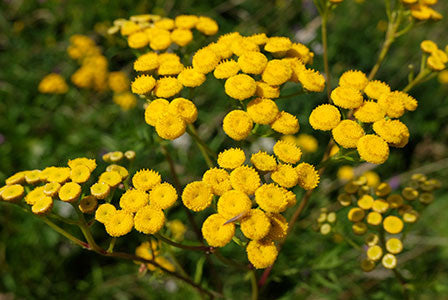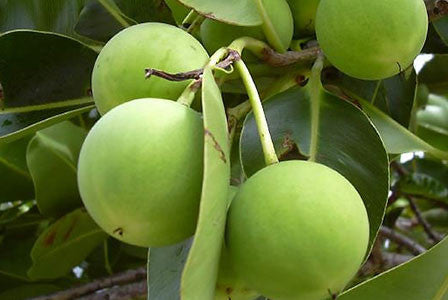Ingredients
Beeswax

- Botanical Name: Cera alba
- Family: Apidae
- Properties: Anti-inflammatory, anti-allergenic, antibacterial, antioxidant, antiviral, emollient, humectant.
- Used For: Beeswax is humectant, attracting water molecules that create a hydrating and protective layer while still allowing skin to breathe. It supports cell reconstruction by supporting collagen production.
- Overview: Beeswax is a natural honey scented wax made by worker bees. Rich in in Vitamin A, Beeswax supports cell reconstruction by supporting collagen production. Beeswax is humectant, attracting water molecules that create a hydrating and protective layer while still allowing skin to breathe. Beeswax offers anti-inflammatory, anti-allergenic, antibacterial and antiviral benefits that soothe and promote healing of easily irritated skin.
- Found in: Soothing Body Balm, On the Go Body Balm, Rescue Salve, Baby Bottom Balm.
Calendula

- Botanical Name: Calendula officinalis
- Family: Asteraceae (Aster)
- Parts Used: Flowers
- Properties: Antifungal, antiviral, antiseptic, anti-inflammatory, emmanagogue (stimulates blood flow in the pelvic area and uterus), lymphatic, vulnerary (wound healing)
- Used For: Varicose veins, athletes foot, wounds, ulcers, burns. Chicken pox, measles, diaper rash, eye wash, swollen lymph glands, dysmenorrhea (painful menstruation), scars
- Overview: It has an ancient reputation of being beneficial in reducing inflammation and promoting wound healing. It has been used to treat a variety of skin diseases and has been seen effective in treatment of skin ulcerations, eczema, juvenile acne and dry phthiriasis. Calendula contains carotenoids that neutralize damaging free radical molecules and are absorbed in human plasma and tissue, providing nourishment to the skin. Calendula’s antioxidants help to prevent the chances of wounds hardening and forming scars.
- Found in: Soothing Body Balm, Rescue Salve, Rescue+, Baby Coco Herbal Oil.
Cat's Claw

- Botanical Name: Uncaria tomentosa, Uncaria guianensis
- Family: Rubiaceae
- Parts Used: Bark
- Properties: Antibacterial, anti-inflammatory, antimutagenic, antioxidant, antiviral, cytostatic, depurative, diuretic, hypotensive, immunostimulant, vermifuge.
- Used For: May help stimulate the immune system and cleanse of free radicals.
- Overview: Cat’s claw is a woody vine that grows wild in the Amazon rainforest and other tropical areas of Central and South America. Its thorns resemble a cat’s claws. Using cat’s claw for health dates back to the Inca civilization. Those who are pregnant or trying to get pregnant should not use cats claw as it is traditionally used as a contraceptive.
- Found in: Eczema Bath Bag.
- Reference: herbwisdom.com
Chamomile

- Botanical Name: Matricaria recutita
- Family: Asteraceae
- Parts Used: Flowers
- Properties: Extensive scientific research over the past 20 years has confirmed many of the traditional uses for the plant and established pharmacological mechanisms for the plant's therapeutic activity, including anti peptic, antispasmodic, antipyretic, antibacterial, antifungal, and anti-allergenic activity.
- Used For: Soothing and calming effects.
- Overview: Chamomile is an age-old medicinal herb known in ancient Egypt, Greece and Rome. Chamomiles popularity grew throughout the Middle Ages when people turned to it as a remedy for numerous medical complaints including asthma, olic, fevers, inflammations, nausea, nervous complaints, children's ailments, and skin diseases. As a popular remedy, it may be thought of as the European counterpart of the Chinese tonic Ginseng.
- Found in: Baby Coco Herbal Oil, On The Go Body Balm.
- Reference: herbwisdom.com
Coconut

- Botanical Name: Cocos nucifera
- Family: Arecaceae/Palmae
- Parts Used: Seeds
- Properties: Antimicrobial, anti-fungal, anti-viral,antioxidant, anti-bacterial.
- Used For: Dehydrated skin, A breathable protective barrier, rich in Vitamin A.
- Overview: Extracted from the dried inner flesh of the coconut, coconut oil works to prevent skin dryness and flakiness. Coconut oil contains antioxidant Vitamin E that works to protect skin cells from environmental stressors, and deter aging of the skin. Coconut oil contains 3 fatty acids: capric acid, lauric acid and caprylic acid. Each of these acids help to keep harmful microorganism from penetrating the skin membrane. Coconut oil contains important nutrients to help strengthen your cuticles, nails, and skin.
- Found in: On the Go, Soothing, Baby Coco Bottom Balm.
Comfrey

- Botanical Name: Symphytum officinale
- Family: Boraginaceae
- Parts Used: Leaves
- Properties: It contains allantoin, a naturally occurring chemical which is known to help new skin cells form. It also contains other substances that encourage skin health and help to reduce inflammation.
- Used For: It is an ancient herb that has been used topically since antiquity to help heal broken bones. In fact, one of its common names is knitbone.
- Overview: Modern science has confirmed that comfrey contains substances that aid in the healing of bruises and bone, muscle and connective tissue injuries and may help ease joint pain.
- Found in: Rescue Salve, Rescue+, Derma Relief.
Grapeseed

- Botanical Name: Vitus vinifera
- Family: Ampelidae
- Parts Used: Seeds
- Properties: Anti-inflammatory, anti-carcinogenic, antiviral and antibacterial.
- Used For: Assists in skin repair and offers antiseptic as well as mildly astringent properties. The oil can be used to help reduce the appearance of age spots, relieve a sunburn, diminish wrinkles and stretch marks. It is also a wonderful oil to balance oily skin.
- Overview: This oil can help to restore collagen thanks to it being rich in those OPCs (oligomeric proanthocyanidins). These compounds help to eradicate free radicals and promote the restoration of collagen at the cellular level. It makes your skin feel firmer, while also minimizing and preventing signs of damage.
- Found in: Rescue+, On The Go.
Immortelle

- Botanical Name: Helichrysum italicum
- Family: Asteraceae
- Parts Used: Flowers
- Properties: Antioxidant, antibacterial, antifungal and anti-inflammatory.
- Used For: Some of its most popular uses are for acne, skin irritation, treating wounds, infections, digestive problems, supporting the nervous system and heart health, and healing respiratory conditions.
- Overview: It is probably the most important of all essential oils for athletes and those who practice strenuous yoga. It is a superior wound-healing agent with pronounced bruise-resolving, pain-reducing, anti-inflammatory, anti-rheumatic, and anti-arthritic properties. These healing powers are thought to be produced by antioxidant compounds present in the leaves and flowers, substances which are now being studied for potential new drug products.
- Found in: Tamanu+ Frankincense, Tamanu+ Immortelle.
Juniper

- Botanical Name: Juniperus virginiana
- Family: Cypress / Pine family Cupressaceae.
- Parts Used: Leaves and berries
- Properties: Antibacterial, Antirheumatic, Antispasmodic, AntiViral, Aphrodisiac, Aromatic, Astringent, Cicatrisant, Circulation.
- Used For: Astringent, anti-inflammatory and antiseptic and can be very beneficial in cleansing and toning the skin in cases of acne and other skin inflammations such as eczema.
- Overview: Can also be applied topically to treat skin ailments and conditions. It is used to treat conditions like acne, athlete's foot, warts, skin growths, cystitis, psoriasis, and eczema. Cade oil, which comes not from the berries but from the tree's wood, is particularly helpful in treatment of psoriasis on the scalp. Moreover, antibacterial properties make juniper a treatment for skin wounds and snakebites.
- Found in: Tamanu+ Immortelle.
Lavender

- Botanical Name: Lavandula angustifolia
- Family: Labiatae (mint)
- Parts Used: Flowers
- Properties: Pain-relieving, anticoagulant, antidepressant,antifungal, antihistamine, anti-inflammatory, antimicrobial, antiseptic, sedative, regenerative.
- Used For: Soothing skin and inflammation. skin allergies, bites and stings, cuts, dry skin, sunburn, poison ivy, hair loss, wrinkles, stretch marks, dry lips, mosquito repellent, itching, inflamed skin.
- Overview: Lavender has a rich reputation for treating wide variety of skin ailments; rightfully lavender has adopted the nickname “first aid in a bottle”. Known for its soothing properties, Lavender is non-irritating and anti allergenic for most people, except those who have Toxic Overload. Historically used to disinfect the scalp and skin, ease damaged skin, enhance blood circulation and treat respiratory problems. According to dermatologists and aroma therapists, lavender essential oil is one of the most beneficial oils in the treatment of acne. Lavender has a soft clean aroma much celebrated in the cosmetic industry.
- Found in: Balancing Face Toner, Baby Coco Bottom Balm, Superior Stretch Mark Oil, Lavender Soaps, Lavender Bath Fizz.
Neroli Water

- Botanical Name: Citrus aurantium bigaradia
- Family: Rutaceae
- Parts Used: Flowers
- Properties: Antidepressant, aphrodisiac, antiseptic, bactericidal, cordial, carminative, cicatrisant, cytophylactic, disinfectant, antispasmodic, deodorant, digestive, emollient, sedative and tonic substance.
- Used For: The orange blossom scent is great for all skin types. It works as a natural deodorant and can be used on dehydrated or sensitive skin. Diffuse Neroli to help calm the mind and spirit while bringing inner strength and peace.
- Overview: By the end of the 17th century, Anne Marie Orsini, duchess of Bracciano and princess of Nerola, Italy, introduced the essence of bitter orange tree as a fashionable fragrance by using it to perfume her gloves and her bath. Since then, the term "neroli" has been used to describe this essence. Neroli has a refreshing and distinctive, spicy aroma with sweet and flowery notes.The oil and the therapeutic properties of the flowers were particularly valued by the people of Venice, who used it against the plague and other fevers, drank it as a tisane, and rubbed a distilled water into their bodies twice a day.
- Found in: Reviving Face Toner.
Oregon Grape Root

- Botanical Name: Mahonia aquifolium
- Family: Berberidaceae
- Parts Used: Root
- Properties: Astringent, antibiotic, amebicide, anti-inflammatory, alterative, vulnerary and a bitter.
- Used For: Skin conditions such as acne, eczema, psoriasis and allergic rashes are soothed by Oregon grape’s attention. The berberine slows abnormal cell growth in the skin and reduces inflammation, which, in turn, relieves itching.
- Overview: Oregon grape root is renowned among herbalists for its ability to stimulate liver function, improve the flow of bile, and for blood cleansing. Oregon grape root uses have traditionally included treating both liver congestion and infectious conditions of both the stomach and intestines. Another benefit of oregon grape root is its functioning as an antimicrobial.
- Found in: Rescue Salve, Rescue+, Eczema Bath Bag.
- Reference: thepracticalherbalist.com
Plantain

- Botanical Name: Plantago major
- Family: Planaginaceae
- Parts Used: Young leaves
- Properties: Wound healing activity, anti-inflammatory, analgesic, antioxidant, weak antibiotic, immuno modulating and anti-ulcerogenic activity.
- Used For: Invaluable aid in handling pain, cuts, burns, swelling and digestive problems.
- Overview: Avid hikers still pick its leaves for cooling bug bites or nettle burns. Plantain waits patiently in lawns and gardens for people to enjoy; confident it can reclaim its title as “Heal All".
- Found in: Rescue Salve, Rescue+.
Rose Hip

- Botanical Name: Rosa canina
- Family: Rosaceae
- Parts Used: Seeds and fruits of the rose bush.
- Properties: Vitamin C, Vitamin A, Vitamin E, and B-complex, as well as minerals like calcium, iron, selenium, manganese, magnesium, phosphorous, potassium, sulfur, silicon, and zinc. Furthermore, the organic compounds, such as lycopene, pectin, lutein, beta-carotene, are also very powerful and essential to the body. The antioxidant components, which include flavonoids, phytochemicals, and carotenoids also contribute to the health benefits.
- Used For: It has the ability to help regenerate new skin cells. This can be used to treat scars, acne and burns. While it is an astringent, it does not dry out the skin; actually it helps to rehydrate it, keeping the moisture in.
- Overview: Drinking rose hip tea daily will also benefit your skin. Rose hips have a high vitamin A content. Vitamin A is commonly referred to as the "skin vitamin". It helps to regenerate skin cells, healing wounds and scars. It also helps to keep the skin elastic and nourished. This will not only prevent wrinkles, but can actually help to minimize any that have already appeared.
- Found in: Rosehip+.
- Reference: organicfacts.net
Rose Water

- Botanical Name: Rose damascena
- Family: Rosaceae
- Parts Used: Flowers
- Properties: Antibacterial, antioxidant, antitussive, hypnotic, antidiabetic, and relaxant effect on tracheal chains.
- Used For: Helps to maintain your skin's pH balance. Helps fight acne, dermatitis and eczema. Rose water hydrates, revitalizes and moisturizes the skin, and makes it smooth. It also helps to heal scars, cuts and wounds. Rose water cools and tones the skin.
- Overview: For centuries, the Damask rose has symbolized beauty and love. The fragrance of the rose has been captured and preserved in the form of rose water by a method that can be traced to ancient times in the Middle East and later to the Indian subcontinent.
- Found in: Balancing Face Toner.
Tamanu

- Botanical Name: Calophyllum inophyllum
- Family: Calophyllaceae
- Parts Used: Nut kernels
- Properties: There are several laboratory and animal trials showing effectiveness of tamanu as an antibacterial, anticancer, anti-inflammatory, and antiviral agent. However, there is limited evidence from human clinical trials.
- Used For: Hair growth, dehydrated skin, wrinkles, stretch marks.
- Overview: Tamanu is a large tropical tree native to Polynesia and Southeast Asia. In Chinese and Tahitian traditional medicine, tamanu is used for abrasions, acne, anal fissures, blisters, burns (boiling water, sun, x-rays), cuts, diabetic ulcers, dry skin, eczema, herpes sores, insect bites and stings, psoriasis, scars, sore throat, foot and body odor, and for pain from muscle, nerve, shingles, leprous neuritis (inflammation associated with leprosy), or rheumatological etiologies.
- Found in: Tamanu+ Immortelle, Tamanu+ Frankincense, Tamanu+ Sandalwood, Superior Stretch Mark Oil.



